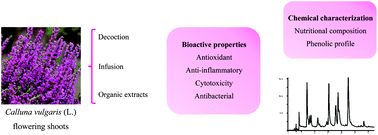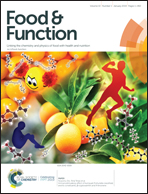Calluna vulgaris (L.) Hull: chemical characterization, evaluation of its bioactive properties and effect on the vaginal microbiota
Abstract
The inflorescences of Calluna vulgaris were nutritionally and chemically characterized. Furthermore, different organic and aqueous extracts were prepared for the evaluation of their bioactive properties. From the obtained results, carbohydrates were the major compounds, followed by protein, lipid and ashes. It was possible to identify the sugars fructose and glucose, five organic acids, 26 individual fatty acids and the four tocopherol isoforms. Concerning the extract composition, 12 phenolic compounds were identified, with myricetin-3-O-glucoside and myricetin-O-rhamnoside predominating. Concerning the bioactive effects, the more polar extracts showed not only the highest amount in phenolic compounds, but also the strongest antioxidant and antibacterial activities. In contrast, for the anti-inflammatory and cytotoxic potential, the most effective extracts were the n-hexane and the ethyl acetate extracts, respectively. C. vulgaris presented a wide range of biological effects, highlighting their capacity to inhibit pathogenic bacteria without affecting beneficial microflora, corroborating their use in traditional medicine.



 Please wait while we load your content...
Please wait while we load your content...